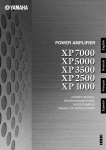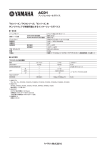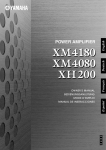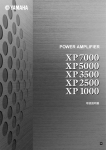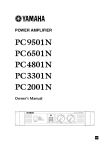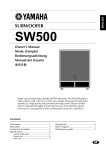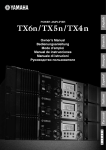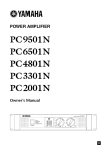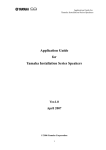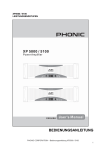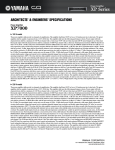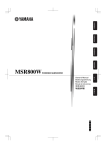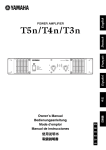Download Yamaha XP2500 Owner`s manual
Transcript
English Français Deutsch POWER AMPLIFIER Español OWNER’S MANUAL BEDIENUNGSANLEITUNG MODE D’EMPLOI MANUAL DE INSTRUCCIONES EN DE FR ES FCC INFORMATION (U.S.A.) 1. IMPORTANT NOTICE: DO NOT MODIFY THIS UNIT! This product, when installed as indicated in the instructions contained in this manual, meets FCC requirements. Modifications not expressly approved by Yamaha may void your authority, granted by the FCC, to use the product. 2. IMPORTANT: When connecting this product to accessories and/or another product use only high quality shielded cables. Cable/s supplied with this product MUST be used. Follow all installation instructions. Failure to follow instructions could void your FCC authorization to use this product in the USA. * This applies only to products (XP7000, XP5000) distributed by YAMAHA CORPORATION OF AMERICA. (oscillator) Explanation of Graphical Symbols The lightning flash with arrowhead symbol within an equilateral triangle is intended to alert the user to the presence of uninsulated “dangerous voltage” within the product’s enclosure that may be of sufficient magnitude to constitute a risk of electric shock to persons. CAUTION RISK OF ELECTRIC SHOCK DO NOT OPEN The exclamation point within an equilateral triangle is intended to alert the user to the presence of important operating and maintenance (servicing) instructions in the literature accompanying the product. CAUTION: TO REDUCE THE RISK OF ELECTRIC SHOCK, DO NOT REMOVE COVER (OR BACK). NO USER-SERVICEABLE PARTS INSIDE. REFER SERVICING TO QUALIFIED SERVICE PERSONNEL. The above warning is located on the top of the unit. IMPORTANT SAFETY INSTRUCTIONS 1 2 3 4 5 6 7 8 9 10 Read these instructions. Keep these instructions. Heed all warnings. Follow all instructions. Do not use this apparatus near water. Clean only with dry cloth. Do not block any ventilation openings. Install in accordance with the manufacturer’s instructions. Do not install near any heat sources such as radiators, heat registers, stoves, or other apparatus (including amplifiers) that produce heat. Do not defeat the safety purpose of the polarized or grounding-type plug. A polarized plug has two blades with one wider than the other. A grounding type plug has two blades and a third grounding prong. The wide blade or the third prong are provided for your safety. If the provided plug does not fit into your outlet, consult an electrician for replacement of the obsolete outlet. Protect the power cord from being walked on or pinched particularly at plugs, convenience receptacles, and the point where they exit from the apparatus. 11 12 13 14 Only use attachments/accessories specified by the manufacturer. Use only with the cart, stand, tripod, bracket, or table specified by the manufacturer, or sold with the apparatus. When a cart is used, use caution when moving the cart/apparatus combination to avoid injury from tip-over. Unplug this apparatus during lightning storms or when unused for long periods of time. Refer all servicing to qualified service personnel. Servicing is required when the apparatus has been damaged in any way, such as power-supply cord or plug is damaged, liquid has been spilled or objects have fallen into the apparatus, the apparatus has been exposed to rain or moisture, does not operate normally, or has been dropped. WARNING TO REDUCE THE RISK OF FIRE OR ELECTRIC SHOCK, DO NOT EXPOSE THIS APPARATUS TO RAIN OR MOISTURE. (98-6500) 2 XP7000/XP5000/XP3500/XP2500/XP1000 Owner’s Manual PRECAUTIONS PLEASE READ CAREFULLY BEFORE PROCEEDING * Please keep this manual in a safe place for future reference. WARNING Always follow the basic precautions listed below to avoid the possibility of serious injury or even death from electrical shock, short-circuiting, damages, fire or other hazards. These precautions include, but are not limited to, the following: Power supply/Power cord Water warning • Only use the voltage specified as correct for the device. The required voltage is printed on the name plate of the device. • Do not expose the device to rain, use it near water or in damp or wet conditions, or place containers on it containing liquids which might spill into any openings. • Use only the included power cord. • Never insert or remove an electric plug with wet hands. • Do not place the power cord near heat sources such as heaters or radiators, and do not excessively bend or otherwise damage the cord, place heavy objects on it, or place it in a position where anyone could walk on, trip over, or roll anything over it. • Be sure to connect to an appropriate outlet with a protective grounding connection. Improper grounding can result in electrical shock. Do not open • Do not open the device or attempt to disassemble the internal parts or modify them in any way. The device contains no user-serviceable parts. If it should appear to be malfunctioning, discontinue use immediately and have it inspected by qualified Yamaha service personnel. If you notice any abnormality • If the power cord or plug becomes frayed or damaged, or if there is a sudden loss of sound during use of the device, or if any unusual smells or smoke should appear to be caused by it, immediately turn off the power switch, disconnect the electric plug from the outlet, and have the device inspected by qualified Yamaha service personnel. • If this device should be dropped or damaged, immediately turn off the power switch, disconnect the electric plug from the outlet, and have the device inspected by qualified Yamaha service personnel. CAUTION Always follow the basic precautions listed below to avoid the possibility of physical injury to you or others, or damage to the device or other property. These precautions include, but are not limited to, the following: Power supply/Power cord • Do not block the vents. This device has ventilation holes at the front and rear to prevent the internal temperature from becoming too high. In particular, do not place the device on its side or upside down. Inadequate ventilation can result in overheating, possibly causing damage to the device(s), or even fire. • Remove the electric plug from the outlet when the device is not to be used for extended periods of time, or during electrical storms. • When removing the electric plug from the device or an outlet, always hold the plug itself and not the cord. Pulling by the cord can damage it. • Do not use the device in the vicinity of a TV, radio, stereo equipment, mobile phone, or other electric devices. Doing so may result in noise, both in the device itself and in the TV or radio next to it. Location • Before moving the device, remove all connected cables. • Do not place the device in a location where it may come into contact with corrosive gases or salt air. Doing so may result in malfunction. • When setting up the product, make sure that the AC outlet you are using is easily accessible. If some trouble or malfunction occurs, immediately turn off the power switch and disconnect the plug from the outlet. Even when the power switch is turned off, electricity is still flowing to the product at the minimum level. When you are not using the product for a long time, make sure to unplug the power cord from the wall AC outlet. • Before connecting the device to other devices, turn off the power for all devices. Before turning the power on or off for all devices, set all volume levels to minimum. • Do not use the device in a confined, poorly-ventilated location. If this device is to be used in a small space other than an EIA-standard rack, make sure that there is adequate space between the device and surrounding walls or other devices: at least 5cm at the sides, 10cm behind and 10cm above. Inadequate ventilation can result in overheating, possibly causing damage to the device(s), or even fire. • Do not expose the device to excessive dust or vibrations, or extreme cold or heat (such as in direct sunlight, near a heater, or in a car during the day) to prevent the possibility of panel disfiguration or damage to the internal components. • Do not place the device in an unstable position where it might accidentally fall over. (5)-4 Connections • Use only speaker cables for connecting speakers to the speaker jacks. Use of other types of cables may result in fire. • Be sure to connect to a properly grounded power source. A ground screw is provided on the rear panel of this device for maximum safety and shock prevention. If the mains outlet is not grounded, be sure to connect the ground screw to a confirmed ground point before plugging the device into the mains. Improper grounding can result in electrical shock. Maintenance • Remove the power plug from the AC outlet when cleaning the device. 1/2 XP7000/XP5000/XP3500/XP2500/XP1000 Owner’s Manual 3 Handling caution • When turning on the AC power in your audio system, always turn on the device LAST, to avoid speaker damage. When turning the power off, the device should be turned off FIRST for the same reason. • Do not insert your fingers or hands in any gaps or openings on the device (vents, etc.). • Do not use the device for a long period of time at a high or uncomfortable volume level, since this can cause permanent hearing loss. If you experience any hearing loss or ringing in the ears, consult a physician. • Do not rest your weight on the device or place heavy objects on it, and avoid use excessive force on the buttons, switches or connectors. • Do not use this device for any purpose other than driving loudspeakers. • Avoid inserting or dropping foreign objects (paper, plastic, metal, etc.) into any gaps or openings on the device (vents, etc.) If this happens, turn off the power immediately and unplug the power cord from the AC outlet. Then have the device inspected by qualified Yamaha service personnel. Yamaha cannot be held responsible for damage caused by improper use or modifications to the device, or data that is lost or destroyed. Always turn the power off when the device is not in use. Even when the power switch is in the “STANDBY”, electricity is still flowing to the device at the minimum level. When you are not using the device for a long time, make sure you unplug the power cord from the wall AC outlet. The performance of components with moving contacts, such as switches, volume controls, and connectors, deteriorates over time. Consult qualifi ed Yamaha service personnel about replacing defective components. Illustrations in this manual are for explanatory purposes only, and may not match the actual appearance of the product during operation. Company names and product names used in this Owner’s Manual are trademarks or registered trademarks of their respective owners. IMPORTANT NOTICE FOR THE UNITED KINGDOM Connecting the Plug and Cord WARNING: THIS APPARATUS MUST BE EARTHED IMPORTANT. The wires in this mains lead are coloured in accordance with the following code: GREEN-AND-YELLOW : EARTH BLUE : NEUTRAL BROWN : LIVE As the colours of the wires in the mains lead of this apparatus may not correspond with the coloured markings identifying the terminals in your plug proceed as follows: The wire which is coloured GREEN-and-YELLOW must be connected to the terminal in the plug which is marked by the letter E or by the safety earth symbol or colored GREEN or GREENand-YELLOW. The wire which is coloured BLUE must be connected to the terminal which is marked with the letter N or coloured BLACK. The wire which is coloured BROWN must be connected to the terminal which is marked with the letter L or coloured RED. • This applies only to products distributed by Yamaha-Kemble Music (U.K.) Ltd. (3 wires) This mark indicates a dangerous electrically live terminal. When connecting an external wire to this terminal, it is necessary either to have “a person who have received appropriate guidance on handling” make the connection or to use leads or a cord that have been manufactured in such a way that the connection can be made simply and without problem. (5)-4 4 XP7000/XP5000/XP3500/XP2500/XP1000 Owner’s Manual 2/2 Introduction Thank you for purchasing a Yamaha XP7000, XP5000, XP3500, XP2500, XP1000 Series Power Amplifier. The XP Series of power amplifiers was developed from Yamaha’s wealth of experience in building PA equipment and its tradition of careful attention to every detail of circuit design. These power amplifiers feature high power — thanks to EEEngine (Energy Efficient Engine) technology — and superb quality together with superior reliability and stability, guaranteeing the highest possible audio performance. Main features include • Three modes are provided to support a broad range of applications: STEREO mode which can be driven by two independent sources, PARALLEL mode in which a monaural source drives both channels, and BRIDGE mode in which the two internal amps function as a single high-power mono amp. • Balanced XLR connector and Euroblock connector inputs, and Speakon connector and five-way binding post outputs are provided. • A high pass filter switch that enables selection of the cutoff frequency (20Hz or 55Hz). • Signal indicator, clip indicator and sophisticated dB step Volume control are provided for each channel. • A PROTECTION indicator that shows the state of various protection systems (power on/off detection, output protection, DC detection), a TEMP indicator that indicates heat sink overheating, and a POWER/STANDBY indicator that indicates the power status. • Variable-speed low-noise fans ensure high reliability. • The XP7000 enables parallel connection of multiple high-impedance speakers that support 70V line output. • The XP3500 enables parallel connection of multiple high-impedance speakers that support 100 V line output. • A MONITOR/REMOTE terminal that allows monitoring or control over the amplifier via a network. This Owner’s Manual applies to the XP7000, XP5000, XP3500, XP2500, XP1000 power amplifier. In order to take full advantage of your power amplifier and enjoy long and trouble-free operation, please read this Owner’s Manual carefully before using your Power Amplifier. Contents Controls and Functions............................6 Front Panel ......................................................... 6 Rear Panel ......................................................... 7 Speaker Connections .............................. 8 Stereo Mode ....................................................... 8 Parallel Mode ..................................................... 8 Bridged Mode (use as high-power mono amplifier) ................... 9 High-impedance speaker connections .. 10 Connection ............................................. 11 Using a Euroblock connector ........................... 11 Speaker Connection ......................................... 11 Troubleshooting ..................................... 12 Specifications ......................................... 13 General Specifications ..................................... 13 MONITOR/REMOTE PIN layout ...................... 15 Dimensions ...................................................... 15 Block Diagram .................................................. 16 Current Draw .................................................... 18 XP7000/XP5000/XP3500/XP2500/XP1000 Owner’s Manual 5 Controls and Functions ■ Front Panel 2 7 1 4 3 5 6 7 * The illustration shows model XP7000. 1 POWER switch and indicator Press this to turn the power on or off. The POWER/ STANDBY indicator lights up in green when the power is ON. If the amplifier has been set to STANDBY mode, the indicator is lit in orange. 2 TEMP indicator Lights up red if the heat sink temperature exceeds 85°C (185°F). 3 PROTECTION indicator When the protection system is active, the PROTECT indicator light up in red and the speakers are automatically disconnected from the amplifier’s outputs. The protection system activates in the following situations: When the amplifier is turned on The protection system activates for approximately three seconds when the amplifier is turned on. After three seconds, the protection system deactivates automatically and the amplifier is ready for normal operation. 5 SIGNAL indicator Lights up green when the corresponding channel’s output level exceeds 2 Vrms (equivalent to 1/2 W into an 8 Ω load, or 1 W into a 4 Ω load). 6 Volume control knobs Each control knob adjusts the volume of the corresponding channel, in 31 steps from -∞ dB to 0 dB. * If you wish to lock in the knob settings, you can fasten the supplied security cover over the knobs so that the settings will not be disturbed. ● How to install the security cover (1) Use the supplied hex wrench to remove the four attachment screws from the amplifier. (2) Adjust the security cover to the position of screw holes. Fasten it into place using the same screws. If a DC voltage is detected at the amplifier’s outputs XP7000/5000: Power shut down and the indicator is not lit. XP3500/2500/1000: The protection system is active. Once the DC voltage problem is corrected, the protection system deactivates automatically and the amplifier is ready for normal operation. If the amplifier overheats When overheating occurs, the PROTECT/MUTE indicator lights. You should immediately turn off the amplifier and allow it time to cool down. See the Precautions section of this Owner’s Manual for ways to prevent the amplifier from overheating. 4 CLIP indicator Lights up red when the output signal distortion on the corresponding channel rises above 1% — indicating that “clipping” has occurred bacause the signal level is too high. 7 Air intakes The amplifier uses forced-air cooling. The cooling fans draw air in from the front and exhaust it through the rear. Please be sure that you do not block the air intakes or exhaust vents. * The fans do not come on at initial power-on, but will switch on automatically when the temperature of the heat sink rises above 50°C (122°F). The fan speed will then vary automatically as the temperature changes. Front Air intake 6 XP7000/XP5000/XP3500/XP2500/XP1000 Owner’s Manual Rear Air exhaust ■ Rear Panel 4 3 1 5 2 1 XLR inputs connectors 7 8 5 MODE switch These balanced XLR-3-31 type connectors are used to connect input signals. The pins are wired as shown below (IEC 60268). Hot 7 6 Ground Cold * In bridged mode, only the first channel in the pair is active; i.e., channel A of pair A/B. Make sure not to input an audio signal to an inactive input terminal. 2 Euroblock connectors These balanced Euroblock connectors are used to connect input signals. 3 HPF switches These switches are used to turn on and off the HPF (High Pass Filter) for each channel. When this is set to 20Hz or 55Hz, frequencies below the respective settings are filtered using a 12 dB/octave high pass filter. 4 GAIN switch This switch is used when changing the Gain of the A and B channels simultaneously. • +4dBu: The maximum output power can be obtained when +4dBu is input. • 26dB: Setting of 26dB • 32dB: Setting of 32dB • STEREO mode In STEREO mode, channels A and B are completely independent. • PARALLEL mode In PARALLEL mode, the channel A input signal is sent both to the channel A power amp and the channel B power amp. In this case, loads are automatically connected between the A and B input terminals. • BRIDGED mode In BRIDGED mode, channels A and B operate simultaneously, functioning as a single mono amplifier. Note: When in PARALLEL and BRIDGED modes, input terminals A and B are shorted automatically. Make sure not to input an audio signal to an inactive input terminal. 6 MONITOR/REMOTE terminals This terminal is used to connect the external device for monitoring or remote control. Refer to “MONITOR/ REMOTE PIN layout” on page 15. 7 SPEAKERS terminals 1: These 5-way binding posts are used to connect speakers. 2: These are Speakon type output jacks. Speakon type cable plugs can be connected here. 8 GND terminal If you are having a problem with hum or noise, use this terminal to connect to ground (earth) or to connect to the chassis of a mixer, preamp, or other device in your system. XP7000/XP5000/XP3500/XP2500/XP1000 Owner’s Manual 7 Speaker Connections Speakers can be connected to the amplifier in three ways, as shown below. Note that speaker impedance will vary according to the connection method and the number of speakers. Please be sure that your speaker's impedance is not less than the relevant minimum value indicated below. ■ Stereo Mode Set the Mode switch to STEREO to use the unit as a stereo amplifier. The volume controls on the front panel (A and B) let you control the volume of each channel independently. ● 5-way binding post ● Speakon connector – + + 4Ω* – 4Ω* 4Ω* * Minimum speaker impedance 4Ω* * Minimum speaker impedance ■ Parallel Mode Set the Mode switch to PARALLEL to use the unit as a two-channnel mono amplifier. The volume controls on the front panel (A and B) let you control the volume of each channel independently. Note: In this case, the loads for A and B are connected directly in the amplifier. Make sure not to input any signal to the B terminal. ● 5-way binding post ● Speakon connector – + 4Ω* + – 4Ω* * Minimum speaker impedance 8 XP7000/XP5000/XP3500/XP2500/XP1000 Owner’s Manual 4Ω* 4Ω* * Minimum speaker impedance ■ Bridged Mode (use as high-power mono amplifier) Set the Mode switch to BRIDGE to use the unit as a high-power mono amplifier. The volume control A on the front panel A lets you control the volume. Note: In this case, the loads for A and B are directly connected in the amplifier. Make sure not to input any signal to the B terminal. ● 5-way binding post ● Speakon connector – + Minimum speaker impedance: 8Ω Minimum speaker impedance: 8Ω XP7000/XP5000/XP3500/XP2500/XP1000 Owner’s Manual 9 High-impedance speaker connections (XP7000/3500 only) The XP7000 enables you to connect in stereo or parallel fashion multiple high-impedance speakers that support 70V line output. The number of speakers that can be connected varies depending on the speaker’s rated input. You can connect speakers with a total rated input per channel of up to 625 W. For example, if you are using speakers with a rated input of 10 W and 15 W, you can connect up to 31 speakers at 10 W (for 310W), and 21 speakers at 15 W (for 315 W). The total is 625 W per channel. Be sure to use speakers that support the XP7000’s line-out voltage of 70 V. or 1 21 1 31 15W 15W 10W 10W 15W x 21 speakers (315W) 1 31 1 10W 10W x 31 speakers (310W) 10W 10W x 31 speakers (310W) 21 15W 15W 15W x 21 speakers (315W) Total rated input of speakers: 625 W (maximum) Total rated input of speakers: 625 W (maximum) The XP3500 enables you to connect in bridge fashion multiple high-impedance speakers that support 100V line output. You can connect speakers with a total rated input of up to 625 W. Be sure to use speakers that support the XP3500’s line-out voltage of 100 V. 1 31 10W 1 10W 10W x 31 speakers (310W) 21 15W 15W 15W x 21 speakers (315W) Total rated input of speakers: 625 W (maximum) 10 XP7000/XP5000/XP3500/XP2500/XP1000 Owner’s Manual Connection ■ Using a Euroblock connector Use a screwdriver to fix the wires. If cables will be frequently connected and disconnected, as in the case of a portable installation, we recommend that you use ferrules with insulation sleeves. Use a ferrule whose conductor portion has an external diameter of 1.6mm or less, and a length of approximately 7 mm (such as the AI0,5-6WH made by the Phoenix Contact corporation). 1 If the wire insertion ports are closed, turn the screws on top of the connector counterclockwise to open the ports. 2 Insert the wires into the appropriate ports, following the indication of the pole on the input terminal, turn the screws on top of the connector clockwise to fix the wires. 3 Attach the Euroblock connector to the input terminal on the unit. + – G ■ Speaker Connection ● 5-way binding post 1 Turn off the POWER switch. 2 Remove the cover attachment screws and remove the protective cover from the speaker terminals. Be sure that the bare wire ends do not jut out from the terminals and touch the chassis. Chassis Bare wire Screw 3 Remove about 15 mm of insulation from the end of each speaker cable. Pass the bare wire through the holes in the appropriate speaker terminals. Tighten the terminals to securely clamp the wires. Refer to page 8 for speaker polarities. 15mm* 4 Reattach the protective cover over the speaker terminals. Speaker cable * Actual size ● Speakon connector 1 Turn off the POWER switch. 2 Insert the Neutrik NL4FC plugs into the Speakon connector on the rear of the amplifier, and turn clockwise to lock. Neutrik NL4FC plugs CHANNEL Å STEREO or PARALLEL 1+ 1– 2+ 2– A+ A– B+ B– BRIDGE 1+ 1– 2+ 2– + – CHANNEL ı 1+ 1– B+ B– XP7000/XP5000/XP3500/XP2500/XP1000 Owner’s Manual 11 Troubleshooting The following table lists the main causes of abnormal operation and the corrective measures required as well as the protective circuit operation in each case. Indicator(s) Possible Cause Remedy There is a short at a speaker terminal, amplifier terminal, or wire. Locate and correct the cause of the short. The amplifier load is excessive. Use a speaker system with an impedance of at least 4 Ω (STEREO/PARALLEL mode) or 8 Ω (BRIDGE mode). TEMP indicator lights. The heat sink temperature has exceeded 85°C (185°F). Check the ventilation slots, and provide better airflow around the amplifier. The TEMP indicator lights up to indicate temperature warning. PROTECTION indicator lights. The heat sink temperature has exceeded 90°C (194°F). Check the amplifier ventilation conditions and take appropriate measures to improve the airflow around the amplifier. The thermal protection circuit operates to protect the power transistors. Remedy Protection Circuit CLIP indicator lights. Protection Circuit The PC limiter circuit operates to protect the power transistors. ● XP3500, XP2500 Indicator(s) PROTECTION indicator lights. Possible Cause A DC voltage of +2 V/-2 V or greater was generated in the power amplifier’s output circuit. Consult your dealer or the nearest Yamaha service center. The relay operates to protect the speaker system. ● XP7000, XP5000 Indicator(s) Power has been shut down. (All indicators are off.) 12 Possible Cause A DC voltage of +2 V/-2 V or greater was generated in the power amplifier’s output circuit. XP7000/XP5000/XP3500/XP2500/XP1000 Owner’s Manual Remedy Protection Circuit Consult your dealer or the nearest Yamaha service center. The protection circuitry shut off the power to protect the speaker system. Specifications ■ General Specifications XP7000 Output Power 1 kHz THD+N= 1 % 20 –20 kHz THD+N= 0.1 % 1 kHz 20mS nonclip SN Ratio Power Consumption 20Hz-20kHz Standby / Idle 1/8 (4 Ω/Pink noise) 8 Ω/STEREO 4 Ω/STEREO 8 Ω/BRIDGED 8 Ω/STEREO 4 Ω/STEREO 70 V/STEREO RL=8 Ω 8 Ω/BRIDGED 2 Ω/STEREO 4 Ω/BRIDGED (DIN AUDIO) MIN 1 kHz THD+N= 1 % 20 –20 kHz THD+N= 0.1 % 1 kHz 20mS nonclip SN Ratio Power Consumption 20Hz-20kHz Standby /idle 1/8 (4 Ω/Pink noise) 8 Ω/STEREO 4 Ω/STEREO 8 Ω/BRIDGED 8 Ω/STEREO 4 Ω/STEREO 8 Ω/BRIDGED 2 Ω/STEREO 4 Ω/BRIDGED (DIN AUDIO) MIN 1 kHz THD+N= 1 % 20 –20 kHz THD+N= 0.1 % 1 kHz 20mS nonclip SN Ratio Power Consumption 20Hz-20kHz Standby / idle 1/8 (4 Ω/Pink noise) 8 Ω/STEREO 4 Ω/STEREO 8 Ω/BRIDGED 8 Ω/STEREO 4 Ω/STEREO 8 Ω/BRIDGED 100 V/BRIDGED RL=16 Ω 2 Ω/STEREO 4 Ω/BRIDGED (DIN AUDIO) MIN 1 kHz THD+N= 1 % 20 –20 kHz THD+N= 0.1 % 1 kHz 20mS nonclip SN Ratio Power Consumption 20Hz-20kHz Standby / idle 1/8 (4 Ω/Pink noise) 8 Ω/STEREO 4 Ω/STEREO 8 Ω/BRIDGED 8 Ω/STEREO 4 Ω/STEREO 8 Ω/BRIDGED 2 Ω/STEREO 4 Ω/BRIDGED (DIN AUDIO) MIN 1 kHz THD+N= 1 % 20 –20 kHz THD+N= 0.1 % 1 kHz 20mS nonclip SN Ratio Power Consumption 20 Hz-20 kHz Standby / idle 1/8 (4 Ω/Pink noise) 8 Ω/STEREO 4 Ω/STEREO 8 Ω/BRIDGED 8 Ω/STEREO 4 Ω/STEREO 8 Ω/BRIDGED 2 Ω/STEREO 4 Ω/BRIDGED (DIN AUDIO) 120 V 230 V 240 V 525 W+525 W 750 W+750 W 1500 W 500 W+500 W 700 W+700 W 1400 W 1300 W+1300 W 2600 W 525 W+525 W 750 W+750 W 1500 W 500 W+500 W 700 W+700 W 1400 W 1300 W+1300 W 2600 W 500 W 525 W+525 W 750 W+750 W 1500 W 500 W+500 W 700 W+700 W 1400 W 1300 W+1300 W 2600 W 103 dB 5 W / 35 W 500 W 120 V 230 V 240 V 390 W+390 W 590 W+590 W 1180 W 350 W+350 W 450 W+450 W 900 W 625 W 1000 W+1000 W 2000 W 390 W+390 W 590 W+590 W 1180 W 350 W+350 W 450 W+450 W 900 W 625 W 1000 W+1000 W 2000 W 450 W 390 W+390 W 590 W+590 W 1180 W 350 W+350 W 435 W+435 W 870 W 625 W 925 W+925 W 1850 W 102 dB 5 W / 30 450 W 120 V 230 V 240 V 275 W+275 W 390 W+390 W 780 W 250 W+250 W 300 W+300 W 600 W 650 W+650 W 1300 W 275 W+275 W 390 W+390 W 780 W 250 W+250 W 300 W+300 W 600 W 650 W+650 W 1300 W 320 W 275 W+275 W 390 W+390 W 780 W 250 W+250 W 295 W+295 W 590 W 650 W+650 W 1300 W 100 dB 5 W / 25 W 320 W 120 V 230 V 240 V 135 W+135 W 165 W+165 W 330 W 110 W+110 W 125 W+125 W 250 W 250 W+250 W 500 W 125 W+125 W 155 W+155 W 310 W 100 W+100 W 115 W+115 W 230 W 250 W+250 W 500 W 96 dB 5 W / 20 W 170 W 120 W+120 W 155 W+155 W 310 W 100 W+100 W 110 W+110 W 220 W 250 W+250 W 500 W MIN XP1000 Output Power 650 W MIN XP2500 Output Power 240 V 750 W + 750 W 1100 W + 1100 W 2200 W 700 W + 700 W 950 W + 950 W 625 W + 625 W 1900 W 1600 W + 1600 W 3200 W MIN XP3500 Output Power 230 V 750 W + 750 W 1100 W + 1100 W 2200 W 690 W + 690 W 950 W + 950 W 625 W + 625 W 1900 W 1600 W + 1600 W 3200 W 104 dB 5 W / 35 W 650 W MIN XP5000 Output Power 120 V 750 W + 750 W 1100 W + 1100 W 2200 W 700 W + 700 W 950 W + 950 W 625 W + 625 W 1900 W 1600 W + 1600 W 3200 W MIN MIN 170 W 650 W 500 W 450 W 320 W 170 W XP7000/XP5000/XP3500/XP2500/XP1000 Owner’s Manual 13 All Models Power Bandwidth THD+N Intermoduration Distortion Frequency Response Half Power, THD+N= 0.5 % 20 Hz–20 kHz, Half Power 60 Hz:7 kHz, 4:1, Half Power RL=8 Ω, Po=1 W, HPF=OFF 20 Hz-50 kHz Channel Separation Half Power, RL=8 Ω, 1 kHz, Att. max, input 600 Ω shunt 20 Hz–20 kHz, Att. min, (DIN AUDIO) RL=8 Ω, 1 kHz Att. max Residual Noise Damping Factor Voltage Gain MIN MAX MAX MAX TYP MIN 10 Hz-40 kHz 0.1 % 0.1 % 0 dB 0 dB -1 dB MIN 70 dB MAX -70 dBu MIN 350 (XP7000, XP5000), 200 (XP3500, XP2500, XP1000) XP7000 XP5000 XP3500 XP2500 XP1000 Selectable from 32 dB or 26 dB (or +4 dBu input sensitivity) by select switch TYP +4 dBu position Input Sensitivity (dBu) Att. max (Rated Power 8 Ω, 20Hz–20kHz, THD+N = 0.1%) +4 dBu position 26 dB position 32 dB position Maximum Input Voltage Input Impedance Controls MIN TYP Front Panel Rear Panel Connectors Indicators Input Output MONITOR/REMOTE POWER/STANDBY SIGNAL CLIP/LIMIT PROTECTION/TEMP Load Protection Amplifier Protection Power Supply Protection Cooling Power Requirements Dimensions (W x H x D) Weight Included Accessories * These specifications apply to rated power supplies of 120V, 230V and 240V. 0 dBu=0.775 Vrms, Half Power=1/2 Output Power (3 dB below rated power) Specifications and descriptions in this owner’s manual are for information purposes only. Yamaha Corp. reserves the right to change or modify products or specifications at any time without prior notice. Since specifications, equipment or options may not be the same in every locale, please check with your Yamaha dealer. 14 XP7000/XP5000/XP3500/XP2500/XP1000 Owner’s Manual 35.7 dB 34.2 dB 32.7 dB 31.2 dB 27.2 dB XP7000 XP5000 XP3500 XP2500 XP1000 +4 dBu +4 dBu +4 dBu +4 dBu +4 dBu +12.2 dBu +10.7 dBu +9.2 dBu +5.2 dBu +13.7 dBu (120V / 240V) +13.6 dBu (230V) +7.7 dBu (120V / 240V) +6.2 dBu +4.7 dBu +3.2 dBu -0.8 dBu +7.6 dBu (230V) +22 dBu 20 kΩ (balanced), 10 kΩ (unbalanced) POWER switch (push on/push off) attenuator (31 position) x 2 MODE switch (STEREO/BRIDGED/PARALLEL) x 1 HPF switch (20 Hz/55 Hz/OFF 12 dB/oct) x 2 GAIN SELECT switch (32 dB/26 dB/+4 dBu) x 1 XLR-3-31 type/ch, Euroblock connector (balanced) /ch SPEAKON/ch, 5 way binding post x 1 Dsub 15 P x 1 x 1 (Green/Orange) x 2 (Green) x 2 (Red) x 1 (Red) x 1 (Red) heatsink temp. ≥ 85 °C POWER switch on/off mute DC-fault: power supply shutdown/operation not restored automatically. (XP7000, XP5000) output relay off/restored automatically. (XP3500, XP2500, XP1000) Clip limiting : THD ≥ 0.5 % Thermal: Cuts the output (heatsink temp. ≥ 90 °C) ; operation not restored automatically. VI limiter (RL ≤ 1 Ω): Limit the output. Thermal: Power supply shutdown (heatsink temp. ≥ 100 °C) ; operation not restored automatically. (XP7000, XP5000). power supply shutdown (transfomer temp. ≥ 130 °C) ; restored automatically. (XP3500, XP2500, XP1000) Variable-speed fan: x 1(XP3500, XP2500, XP1000), x 2 (XP7000, XP5000) Fan stop at heatsink temp. < 55 °C 120V, 220V–240V; 50Hz/60Hz 480 x 88 x 456 mm (18-7/8" x 3-7/16" x 17-15/16") XP7000 XP5000 XP3500 XP2500 XP1000 14.0 kg 14.0 kg 15.0 kg 14.0 kg 12 kg (30.9 lbs) (30.9 lbs) (33.1 lbs) (30.9 lbs) (26.5 lbs) Security cover (with a hex wrench), Owner’s Manual European models Purchaser/User Information specified in EN55103-1 and EN55103-2. Inrush Current: XP7000/5000 25A , XP3500 22A, XP2500 20A, XP1000 14A Conforms to Environments: E1, E2, E3 and E4 ■ MONITOR/REMOTE PIN layout Pin No. 1 2 3 Signal GND REMOTE CONTROL MONITOR 4 5 6 7 REMOTE CONTROL 8 9 10 11 12 13 14 15 MONITOR Description STANDBY MODEL ID STANDBY Control: Supply 5 VDC, 5 mADC XP7000: 1.0 kΩ, XP5000: 1.2 kΩ, XP3500: 1.5 kΩ, XP2500: 1.8 kΩ, XP1000: 2.2 kΩ (Impedance to GND) NC NC MUTE CH B MUTE CH A MUTE On Control: Connect the pin to GND (max. 1mA flows) MUTE Off Control: Open the pin (+5V applied) NC NC PROTECTION/MUTE STATUS CH B PROTECTION/MUTE STATUS CH A NC NC OUTPUT LEVEL CH B OUTPUT LEVEL CH A Protection/Mute On: +5 VDC, Zo=270 Ω Protection/Mute Off: 0 VDC, Zo=High XP7000, XP5000, XP3500, XP2500, XP1000 +4dBu (-27.2 dB of Speaker Output Level) at 100 W/8Ω, RL=7.5 kΩ, Zo=300 Ω ■ Dimensions 46 5.5 456 374.5 30 Unit: mm 362 30 480 88 30 XP7000/XP5000/XP3500/XP2500/XP1000 Owner’s Manual 15 16 XP7000/XP5000/XP3500/XP2500/XP1000 Owner’s Manual – + G – + G 3 2 LINE FILTER XLR 1 Euroblock FG CH B [+22dBu MAX] INPUT CH A 3 2 XLR 1 +24 RELAY DRIVE CIRCUIT RELAY POWER SW GR/OR (GR+RE) POWER/STANDBY PARALLEL BRIDGE STEREO PARALLEL BRIDGE STEREO CH B ATT CH A ATT U, A destination J, H destination Thermal cutoff SUB TRANS PO SBY LED DRIVE CIRCUIT HA HA MODE BA BA HPF 55Hz OFF 55Hz TEMPERATURE SENSOR OVERCURRENT DETECT CIRCUIT DRIVER LATCH CIRCUIT LIMITER PA PA –15V +15V +5V GR GR FAN (R) FAN (L) +24 –B +B –24 –15 +15 +5 B DC PR RE SHUTDOWN BPS B MUTE APS A MUTE LED DRIVE CIRCUIT TM RE TEMP PROTECTION PROTECTION CIRCUIT B MUTE TEMP A DC ASIG BSIG A MUTE ACL BCL POWER ON DETECT CIRCUIT LIMITER TEMPERATURE SENSOR +60˚C +90˚C TEMPERATURE SENSOR +60˚C +90˚C FAN CONTROL CIRCUIT MAIN TRANS PARALLEL BRIDGE STEREO INV SHUTDOWN CIRCUIT +100˚C 55Hz 20Hz SWITCHING HPF 55Hz HPF 20Hz HPF 12dB/oct +15V +4dBu +26dB +32dB GAIN +4dBu +26dB +32dB OFF HPF 20Hz 20Hz RE LED DRIVE CIRCUIT RE SIGNAL CH A CH B CLIP/LIMIT CH A CH B 1+ 2+ 2– 2– – – + + CH B-1 (A+B BRIDGE) CH A-1 OUTPUT (SPEAKERS) CH B-2 CH A-2 (A+B BRIDGE) B OUTPUT LEVEL A OUTPUT LEVEL MUTE PROTECT STATUS STANDBY Model ID DATA PORT (MONITOR/REMOTE) 5way 2+ SPEAKON 1– 1– SPEAKON 1+ ■ Block Diagram ● XP7000/XP5000 – + G – + G 3 2 XLR 1 FG Except J destination PARALLEL BRIDGE STEREO PARALLEL BRIDGE STEREO POWER/STANDBY POWER SW GR/OR (GR+RE) J destination only CH B Euroblock [+22dBu MAX] INPUT CH A 3 2 XLR 1 RELAY 2 Thermal cutoff BA BA RELAY & LED DRIVE CIRCUIT MODE CH B ATT CH A ATT RELAY 1 SUB TRANS HA HA PO SBY HPF 55Hz OFF 55Hz 55Hz Thermal Thermal cutoff protector MAIN TRANS HPF 55Hz HPF 20Hz 20Hz HPF 12dB/oct 130˚C +4dBu +26dB +32dB GAIN +4dBu +26dB +32dB OFF HPF 20Hz 20Hz PARALLEL BRIDGE STEREO INV –15V +15V +90˚C PA –B +B –24 –15 +15 FAN PA B DC A DC TEMP SP RELAY B RY PROTECTION CIRCUIT A RY PR RE BPS B MUTE APS A MUTE LED DRIVE CIRCUIT TM RE TEMP PROTECTION SP RELAY ASIG BSIG FAN CONTROL CIRCUIT +60˚C TEMPERATURE SENSOR +24 LIMITER LIMITER ACL BCL LED DRIVE CIRCUIT GR GR RE RE SIGNAL CH A CH B CLIP/LIMIT CH A CH B 1+ 2– – CH A-1 + CH B-1 – (A+B BRIDGE) + OUTPUT (SPEAKERS) CH B-2 B OUTPUT LEVEL A OUTPUT LEVEL MUTE PROTECT STATUS STANDBY Model ID DATA PORT (MONITOR/REMOTE) 5way 2+ SPEAKON 1– 2+ SPEAKON 1+ CH A-2 1– 2– (A+B BRIDGE) ● XP3500/XP2500/XP1000 XP7000/XP5000/XP3500/XP2500/XP1000 Owner’s Manual 17 ■ Current Draw XP7000 Line Current (A) 100/120V Power (W) 230/240V In Out Thermal Dissipation Dissipated Btu/h kcal/h standby 0.08 0.04 5 0 5 17 4 idle 1.0 0.5 35 0 35 119 30 1/8 power 1/3 power 8Ω/ch 5.4 3.0 379 188 191 653 165 4Ω/ch 8.5 4.7 611 275 336 1150 289 8Ω/ch 12.8 7.0 918 500 418 1430 360 4Ω/ch 20.6 11.3 1481 733 748 2550 643 XP5000 Line Current (A) 100/120V Power (W) 230/240V In Out Thermal Dissipation Dissipated Btu/h kcal/h standby 0.08 0.04 5 0 5 17 4 idle 1.0 0.5 35 0 35 119 30 1/8 power 1/3 power 8Ω/ch 4.0 2.2 277 131 146 499 126 4Ω/ch 6.2 3.4 436 188 249 848 214 8Ω/ch 9.3 5.1 673 350 323 1100 278 4Ω/ch 14.7 8.1 1057 500 557 1900 479 XP3500 Line Current (A) 100/120V Power (W) 230/240V In Out Thermal Dissipation Dissipated Btu/h kcal/h standby 0.08 0.04 5 0 5 17 4 idle 1.0 0.5 30 0 30 102 26 1/8 power 1/3 power 8Ω/ch 3.2 1.7 227 98 130 443 112 4Ω/ch 5.0 2.8 378 148 231 787 198 8Ω/ch 7.3 4.0 551 260 291 993 250 4Ω/ch 12.2 6.7 917 393 524 1790 450 XP2500 Line Current (A) 100/120V Power (W) 230/240V In Out Thermal Dissipation Dissipated Btu/h kcal/h standby 0.08 0.04 5 0 5 17 4 idle 1.0 0.5 25 0 25 85 22 1/8 power 1/3 power 8Ω/ch 2.4 1.3 174 69 105 358 90 4Ω/ch 3.6 2.0 271 98 173 592 149 8Ω/ch 5.6 3.1 421 183 238 811 204 4Ω/ch 8.8 4.8 657 260 397 1350 341 XP1000 Line Current (A) 100/120V Power (W) 230/240V In Out Thermal Dissipation Dissipated kcal/h standby 0.08 0.04 5 0 5 17 4 idle 1.0 0.5 20 0 20 68 17 8Ω/ch 1.1 0.6 76 28 48 165 42 4Ω/ch 1.2 0.7 91 30 61 208 52 8Ω/ch 2.4 1.3 184 73 110 376 95 4Ω/ch 2.9 1.6 220 80 140 479 121 1/8 power 1/3 power 1/8 power is typical of program material with occasional clipping. Refer to these figures for most applications. 1/3 power represents program material with extremely heavy clipping. Test signal: Pink Noise, bandwidth limited from 22Hz to 22kHz 1W = 0.860kcal/h, 1BTU = 0.252kcal Note that Line Voltage [V] x Line Current [A] = [VA], not equals to [W]. Inrush current XP7000, XP5000: XP3500: XP2500: XP1000: 18 Btu/h 11A (100V), 13A (120V), 25A (240V) 11A (100V), 13A (120V), 22A (240V) 10A (100V), 12A (120V), 20A (240V) 9A (100V), 11A (120V), 14A (240V) XP7000/XP5000/XP3500/XP2500/XP1000 Owner’s Manual Memo XP7000/XP5000/XP3500/XP2500/XP1000 Owner’s Manual 19 Memo 20 XP7000/XP5000/XP3500/XP2500/XP1000 Owner’s Manual Yamaha Pro Audio global web site: http://www.yamahaproaudio.com/ Yamaha Manual Library: http://www.yamaha.co.jp/manual/ C.S.G., Pro Audio Division © 2005 Yamaha Corporation 305POAPx.x-01E0 Printed in Vietnam WF37200






















